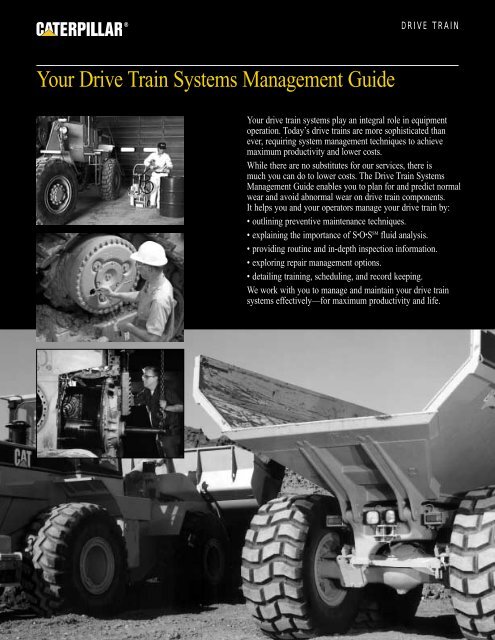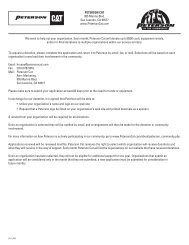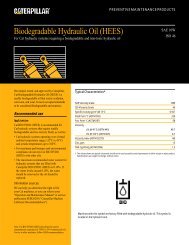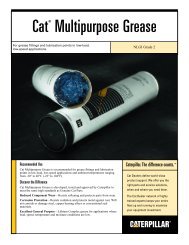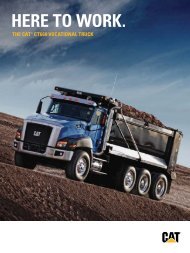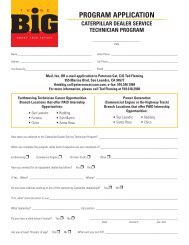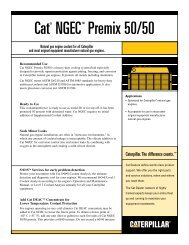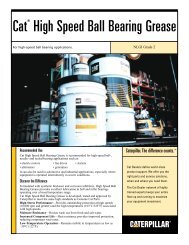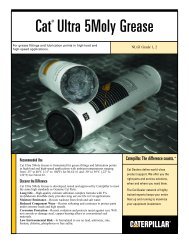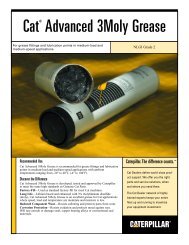Your Drive Train Systems Management Guide - Peterson CAT
Your Drive Train Systems Management Guide - Peterson CAT
Your Drive Train Systems Management Guide - Peterson CAT
- No tags were found...
Create successful ePaper yourself
Turn your PDF publications into a flip-book with our unique Google optimized e-Paper software.
®DRIVE TRAIN<strong>Your</strong> <strong>Drive</strong> <strong>Train</strong> <strong>Systems</strong> <strong>Management</strong> <strong>Guide</strong><strong>Your</strong> drive train systems play an integral role in equipmentoperation. Today’s drive trains are more sophisticated thanever, requiring system management techniques to achievemaximum productivity and lower costs.While there are no substitutes for our services, there ismuch you can do to lower costs. The <strong>Drive</strong> <strong>Train</strong> <strong>Systems</strong><strong>Management</strong> <strong>Guide</strong> enables you to plan for and predict normalwear and avoid abnormal wear on drive train components.It helps you and your operators manage your drive train by:• outlining preventive maintenance techniques.• explaining the importance of S•O•S SM fluid analysis.• providing routine and in-depth inspection information.• exploring repair management options.• detailing training, scheduling, and record keeping.We work with you to manage and maintain your drive trainsystems effectively—for maximum productivity and life.X
ContentsIntroductionSeven elements of drive train systems managementInclude all seven elements in your management programPreventive maintenanceMake sure oil properly cleans, cools, and lubricates partsMake sure fluid filters effectively control contaminationS·O·S fluid analysisUnderstand S•O•S fluid analysisUse the correct method to take samplesInspectionsLocate potential problems with thorough inspectionsRecognize repair indicatorsFollow an inspection scheduleRepair managementControl costs and downtime with repair management options<strong>Train</strong>ing, scheduling, and record keepingLower costs with effective training, scheduling,and record keeping33445-6567778-11891012-131214-1514
Seven elements of drive train systems managementInclude all seven elements in your management programPreventive maintenanceS•O•S fluid analysisPreventive maintenance includes manytechniques—like correctly selecting andchanging drive train oil and fluid filters—thathelp you keep small problems from becomingmajor repairs.S•O•S fluid analysis is the best way for you tomonitor what is happening inside your drivetrain systems. It consists of tests that enable youto forecast wear-related problems.InspectionsInspections combine your daily walkaroundchecks and our periodic technical analyses.They allow you to detect potential problemsand impending failures, so you can schedulemaintenance and repairs.Repair managementRepair management helps you select beforefailureand after-failure repair options andcontrol repair costs. It allows you to plan andschedule repairs, so you can get your machinesback to work quickly and reliably.<strong>Train</strong>ingOur training assistance helps you improve themaintenance practices of your staff. It reducesthe chance of failures caused by faultymaintenance and helps you lower your owningand operating costs.SchedulingA good scheduling system ensures thatmaintenance, inspections, and planned repairsare done on time. It helps you prevent thefailures caused by overlooked maintenance.Record keepingRecord keeping consists of full documentationon machine history, component life, and costinformation. It helps you identify high-cost orproblem areas, track work flow, control costs,and increase machine resale value.4
DRIVE TRAINPreventive maintenanceRegular preventive maintenance is themost cost-effective way to keep yourdrive train systems operating at peakperformance. Preventive maintenance:• allows you to schedule downtimeand plan for maintenance andrepair costs.• helps prevent major failures andfailures of related parts.• saves you money because youcan often repair before failure.• maximizes parts reusability.• optimizes equipment life to keepyour machines on the job.•increases machine resale value.By properlymanaging changeintervals, you getoptimum use offluid’s lubricatingand protectingproperties andmaximumcomponent life.Clean, cool, and lubricate drive train parts with proper oil use<strong>Drive</strong> train oil performs three main functions:cleaning, cooling, and lubricating transmissionand final drive components. Since today’sCat ® drive train systems feature new metals,elastomers, and paper disc materials thatrequire advanced lubrication, you must changeoil regularly and properly and use the rightdrive train oil to achieve top performance.Change oil regularlyOil provides a protective film to separatetransmission and final drive components, whichoperate with very tight tolerances. Changing oilat proper intervals is critical to realizingmaximum component life. We recommend thatyou change oil every 1000 hours, but that isjust a guideline. Actual oil life is determined bymany factors, including operating conditions.By monitoring S•O•S fluid analysis results,we’ll help you establish proper intervals.Properly managing change intervals also meansyou get optimum use of the fluid’s lubricatingand protecting properties and maximumcomponent life. Changing fluids too earlywastes money because you throw away someuseful life. Changing fluids too late allows oilto deteriorate and shortens component life.Determining the best change interval takessome effort, but the reward is significantlylower operating costs.Change oil properlyIt’s also critical that you change oilproperly. You can reduce the chance ofcontamination by:• draining oil when it is warm and agitated.• draining dirty oil as completely as possible.• using a filtered transfer cart to add new oil.Use the right drive train oilFor years, it was standard practice to use thesame oil in both engine and drive train systems.Today’s transmissions and final drives,however, require lubrication that engine oilscannot provide. <strong>Drive</strong> train oil for yourtransmissions and final drives must meetCaterpillar TO-4 specifications, which includefrictional and gear wear requirements.Engine oils reduce friction between movingparts. <strong>Drive</strong> train oils allow some frictionbetween discs and plates as they engage—friction that is critical to proper drive trainperformance. By using drive train oil instead ofengine oil, you dramatically extend disc life.Using Cat Transmission/ <strong>Drive</strong> <strong>Train</strong> Oil(TDTO) is the safest way to ensure top drivetrain performance. In new Cat machines, it canextend transmission disc life up to 45% over aCD/SF TO-2 engine oil. Cat TDTO also:• improves gear wear performance significantly.• eliminates transmission slippage.• controls brake chatter.• increases machine break-out force.• provides greater machine rim pull.5
Preventive maintenanceControl contamination with proper filter useFluid filters work in unison with your drive trainoil to control contamination inside your drivetrain system. By changing filters regularly andproperly and by selecting the right filters, youmaintain drive train system cleanliness, reducecomponent wear, and lower costs.Change filters regularlyTo keep your drive train system operating atpeak performance and reduce the chance ofcontamination, which can cause componentwear and system failure, always change yourfluid filters at regular intervals. We recommendchanging fluid filters every 500 hours.Change filters properlyOld filters contain contaminants, so removefilters carefully at change time to ensure thatcontaminants do not reenter the drive trainsystem. In addition, keep new filters in theirpackaging until you are ready to install them.Select the right fluid filtersQuality fluid filters feature media that removeharmful particles that can cause componentwear. They are resistant to leaks and structuralfailures and are constructed to ensure every bitof oil passes through the media. Even if only1% of oil fails to pass through the media, filterefficiency drops and the possibility ofcontamination increases.To protect transmission and final drivecomponents effectively, Cat fluid filters meethigher standards and more rigid specificationsthan standard filters. Cat fluid filters feature:• resin-impregnated media to meet Caterpillar’srigid capacity and efficiency specs.• self-lubricating, free-rotating seal design toprevent bunching, improve sealing, andeliminate leaks.• non-metallic core, which is stronger thanmetal and eliminates metal contamination.• one-piece “auto-spun” canister design toincrease structural strength and preventpossible ruptures.• unique fiberglass spiral roving design toeliminate pleat flexing.• one-piece, molded methane end caps toeliminate leaks and metal contamination.6
DRIVE TRAINS• O • S fluid analysisUnderstand S • O • S fluid analysisOil sampling at scheduled intervals detectsshortcomings in your maintenance proceduresand forecasts wear-related problems. Our S•O•Sfluid analysis program is well recognized for itsability to detect potential problems early. Weperform four types of S•O•S analysis tests onyour drive train oil.• Wear Rate Analysis detects, identifies, andassesses the amount and type of wear metalsin oil. The rate at which wear metal particlesincrease from sample to sample is as importantas the quantity of particles in oil.• Oil Cleanliness Analysis uses a particle counttest to detect both metallic and nonmetallicdebris (such as friction disc material) generatedby wear, as well as dirt from outside sources.• Oil Contamination Analysis quantifies silicon—which identifies dirt entry—with spectrometricanalysis. Additional tests are performed forcontamination by water or glycol, which canenter from oil coolers.• Oil Contamination Analysis determines theloss of oil’s lubricating qualities. An infraredanalysis instrument compares the properties ofnew oil to those of your used oil to determineif the oil is performing up to specificationduring the entire oil change period.S•O•S fluid analysis is different from otheranalysis programs because it focuses oncomponent condition, not just oil condition.Since we understand your Cat drive train system,we can help you analyze S•O•S reports, determinewhat additional tests need to be performed, anddecide on the proper corrective action.Take samples regularlyOil analysis is the best way to detect and measurecontaminants in your drive train system and headoff problems before they result in major expenses.Taking samples regularly is critical because itallows for accurate interpretation. While a singlesample may spot contamination or a rapidlyprogressing failure, only several samples takenat regular intervals will establish trends for yourdrive train system. We analyze these trends tohelp you achieve maximum drive trainperformance.Use the correct method to take samplesUsing an oil valve probeUsing vacuum extractionFilling out label accurately• Set the engine at low idle and remove the dust cap from thevalve of the compartment you are sampling.• Insert the probe into the valve and collect about 100 ml (4 fl oz)of oil into a waste container. Dispose of the waste oil properly.If the bottle is slow to fill, it may be necessary to increase theengine speed to high idle.• Insert the probe into the valve again and fill the sample bottleabout three-quarters full—do not fill to the top.• Withdraw the probe and secure the cap on the bottle. Placethe bottle with the completed label into the shipping cylinder.NOTE: Use an oil valve probe for pressurized compartmentsonly. Retrofit valve kits are available for models not equippedwith valves.• Turn off the engine and measure and cut new tubing to thelength of the dipstick. If the compartment you are samplingdoes not have a dipstick, cut the tubing so that it reachesabout halfway into the oil depth.• Insert the tubing through the head of the vacuum pump andtighten the retaining nut. The tubing should extend about4 cm (1 in) beyond the base of the vacuum pump head.• Install a new sampling bottle onto the vacuum pump headand insert the end of the tubing into the oil—do not allowthe tube to touch the bottom of the compartment.• Pump the vacuum pump handle to create a vacuum. Fill thebottle about three-quarters full—do not fill to the top.• Withdraw the tubing, remove the bottle from the vacuumpump, and secure the cap on the bottle. Place the bottlewith the completed label into the shipping cylinder.Providing complete information on the sample label makesprocessing your sample easier. Make sure you includeimportant information like:• machine model and serial number.• service meter units on equipment and oil.• whether or not the oil was changed when the samplewas taken.• amount of make-up oil added since last oil change.7
InspectionsLocate potential problems with thorough inspectionsYou and your operators can take the first stepin inspections by “listening” to your equipment.A good inspection program combines your dailyinspections with our periodic in-depthanalyses to:• locate potential problems before they becomemajor repairs.• schedule drive train maintenance and service.• plan and control your operating costs anddowntime.Perform regular inspections<strong>Your</strong> daily visual inspection routine shouldinclude a complete visual and operational checkof your drive train system. Cat drive traincomponents will generally indicate problemswith advanced warning signs, such as strangenoises, leaks, slippage, and overheating.We can help you with these inspections by:• providing customized machine checklists.• training your operators to perform dailywalkarounds.• teaching your operators to recognizerepair indicators.Final drive warning signsPerforming proper maintenance and takingaction when telltale warning signs appear canprevent catastrophic gear and bearing failure.Call us if you notice:• oil leaks.• large metal particles on the magnetic plug.• unusual noises or vibrations.Transmission warning signsThe chart on the following page summarizeswarning signs, their possible causes, andrecommended actions.Utilize our inspection servicesWe offer a number of diagnostic and repairservices to help you understand warning signs.These services will help you make informedrepair decisions.• Repair Indicator Evaluation requires servicerecords, machine hours, and repairindicators. We talk with your operators andevaluate S•O•S reports and trends, magneticplug inspection findings, leaks, noises, andperformance problems.• Technical Analysis Inspection (TA) requiresadvanced diagnostic inspection equipmentand consists of a comprehensive visualinspection, plus a repair indicatorreview and evaluation. After a thoroughanalysis, we’ll issue a recommendationbased on our TA findings.• Repair Determination Inspection (RDI)requires a thorough internal inspectionand is performed when TA results suggestfurther inspection is necessary. It consistsof a guaranteed price for componentdisassembly and evaluation. After theevaluation, we will give you a specificrepair option recommendation or aguaranteed repair quote.8
DRIVE TRAINInspectionsRecognize repair indicatorsIndicators Possible Causes OptionsS·O·S results S•O•S Fluid Analysis provides the best insight into Customer/Dealer Discussioninternal transmission wear and potential failure.Overhaul <strong>Management</strong> <strong>Guide</strong> (OMG) OMG indicates estimated life to overhaul Customer/Dealer Discussionand indicates how you can extend that time bychanging operation and maintenance factors.Hesitation Worn plates and discs Technical Analysis InspectionWrong oil usedRepair Determination InspectionLinkage out of adjustmentCustomer/Dealer DiscussionIncorrect pressure settingsLow fluid levelSlippage Worn plates and discs Technical Analysis InspectionLinkage out of adjustmentRepair Determination InspectionLow fluid levelS•O•S Fluid AnalysisIncorrect pressure settingsWrong oil usedUnusual noises Worn gears/worn bearings Technical Analysis InspectionDirt entryRepair Determination InspectionAeration/cavitationCustomer/Dealer DiscussionLow fluid levelVibration Bent drive shaft Technical Analysis InspectionGear failureRepair Determination InspectionBearing failureS•O•S Fluid AnalysisCustomer/Dealer DiscussionOverheating Wrong oil used Technical Analysis InspectionPlugged radiatorRepair Determination InspectionWorn pumpS•O•S Fluid AnalysisWorn pressure relief valveCustomer/Dealer DiscussionWorn or damaged sealsWorn/dirty control valveDebris in filter/on magnetic screen Dirt entry S•O•S Fluid AnalysisWrong oil usedCustomer/Dealer DiscussionExtended oil change periodWorn gears or bearingsDisc disintegrationLeaks Worn, hard, or cracked seals Repair Determination InspectionCustomer/Dealer DiscussionBent or damaged lines External damage Technical Analysis InspectionRepair Determination InspectionTransmission service meter hours Our PSSRs are trained to use service meter S•O•S Fluid Analysishours as a repair indicator.Customer/Dealer DiscussionOperator discussion Talking with your machine’s operator can Repair Determination Inspectionreveal many potential transmission problems.9
InspectionsFollow an inspection scheduleService meter hours providean easy way to structurechecks and inspections.These scheduled checks canhelp you identify problemsbefore they become serious.Do not, however, substitutethese checks for the specificinformation contained in theLube and Maintenance <strong>Guide</strong>(SEBU6250).Low Sprocket Tractors andPowershift Track LoadersCheck final drive seals daily for leaks.10-hour or daily check• Complete walk-around inspection.• Check final drive seals for leaks.Adjust the sprocket hub bearings.250-hour or monthly check• Check final drive oil level. Position one finaldrive so oil level is horizontal. Drain plugshould face downward. Oil level should beat the bottom of the filler plug opening.Clean the magnet and add oil if necessary.• Remove the fill plug and maintain the oillevel to the bottom edge of the plug opening.• Look for oil leaks if the level is noticeablylow—a substantial leak indicates that sealsand bearings may need replacement.500-hour or quarterly check(reconditioned or rebuilt machines)• Change fluid filters.• Inspect for oil leaks on both sides ofsprockets.• Replace seals and/or bearings if leakage isnoticeable. Refer to the Service Manual orcall us for the correct replacement andadjustment procedure.• Obtain final drive oil samples for S•O•SFluid Analysis.• Obtain transmission oil sample for S•O•SFluid Analysis.1000-hour or six-month check• Change the oil on both sides.• Remove the fill and drain plugs and allowoil to drain.• Check the magnetic plugs (if equipped) formetal particles. If particles are present,schedule a repair as soon as possible.• Wipe particles off the magnet and retainthese particles for comparison purposesat the next change interval.• Clean and reinstall the drain plug.• Refill to the bottom edge of the fill plugopening with Caterpillar Transmission/<strong>Drive</strong><strong>Train</strong> Oil or oil meeting Caterpillar TO-4specifications.• Clean and reinstall the fill plug.2000-hour or annual check• Adjust the sprocket hub bearings (refer tothe Service Manual for proper procedureor give us a call).• Adjust valves.• Change final drive oil.10
DRIVE TRAINWheel Loaders andIntegrated ToolcarriersPerform a walk-around inspection daily.10-hour or daily check• Complete walk-around inspection.• Check final drive seals for leaks.• Check lubricant levels in the front andrear differentials and final drives if leaksdevelop or are suspected.• Operate the machine a few minutes toallow the oil to reach a common levelbefore checking it.• Park the machine on level ground, applythe parking brake, and stop the engine.• Add lubricant to bring the oil level to thebottom of the fill plug opening.• Repeat this procedure on the rearaxle housing.250-hour or monthly check• Check final drive oil level.• Position one final drive so the oil level ishorizontal. Drain plug should face downward.Oil level should be at the bottom ofthe filler plug opening.• Clean the magnet and add oilif necessary.Remove, clean, and reinstall the fill plugevery 2000 hours or annually.500-hour or quarterly check(reconditioned or rebuiltmachines)• Change fluid filters.• Align each wheel with the magneticdrain plug up. Remove the plug and inspectfor metal particles. If present, schedule arepair as soon as possible. Wipe particlesoff the magnet and retain them for comparisonpurposes at the next inspection.• Obtain final drive oil samples for S•O•SFluid Analysis.• Obtain transmission oil sample for S•O•SFluid Analysis.2000-hour or annual check• Change the oil in the front and reardifferentials and final drives.• Park the machine on level ground andposition each wheel with the drainplug at the lowest point.• Remove each final drive drain plug anddrain the oil.• Remove the front and rear differentialdrain plugs and drain the oil.• Clean and reinstall all differential andfinal drive drain plugs.• Remove the differential fill plug fromthe front axle.• Fill the front differential and finaldrives with oil that meets Cat TO-4specifications.• Clean and reinstall the fill plug.• Repeat the filling process for the rearaxle housing.• Operate the machine for one hour,then stop and inspect for leaks.• Remove the fill plugs and maintain theoil level to the bottom of the opening.If the oil level is above the opening,do not allow the oil to drain to thebottom of the opening.• Reinstall the fill plug.• Add oil to bring the oil level to thebottom of the fill plug opening.• Use this procedure on both the frontand rear axles.11
Repair managementControl costs and downtime with repair management optionsPreventive maintenance, S•O•Sfluid analysis,and inspections help you catch problems intheir earliest stages. With a good drive trainmanagement program that includes these threesteps, you can make informed decisions aboutmaintenance and repair—optimizing repairtiming and minimizing repair costs.Repair management helps you control repaircosts and downtime by enabling you to selectoptions at the time of repair. To take advantageof repair management, you must respond torepair indicators quickly—so you can repairbefore failure.Respond to repair indicators quickly<strong>Your</strong> Cat drive train system is built to help youavoid costly drive train failure. Certaincomponents are designed to wear, and yourdrive train will indicate when they needreplacement. Responding quickly to the repairindicators listed on page 9 allows you to choosebefore-failure repair options and replace worncomponents before they cause major damage.Overhaul <strong>Management</strong> <strong>Guide</strong>The Overhaul <strong>Management</strong> <strong>Guide</strong> (OMG) cansignificantly reduce your owning and operatingcosts. When used with other drive trainmanagement techniques, OMG helps usidentify estimated life to before-failureoverhaul for your transmission and final drives.It also:• indicates how you can extend the time for anoverhaul by changing operating andmaintenance factors.• provides increased opportunities for repairbefore failure.• allows for more accurate budgeting andscheduling of repairs.Contact our parts and service professionals toschedule a demonstration of OMG.Before-failure repairsRepair before failure to save timeand moneyRepairing before failure gets your machinesback to work sooner and costs two to threetimes less than the price of after-failure repairs.Our before-failure repair options:• help prevent major failures and failureof related parts.• maximize parts reusability.• allow you to schedule downtime andplan costs.• maximize equipment life and keep yourmachine on the job.TransmissionRebearing and resealRebearing and reseal is recommended whenS·O·S results, a visible leak, or compartmenthours signal a need for repair, or when anotherpart of the common oil system fails and spreadsdebris into the transmission. This procedureincludes disassembly and assembly of thetransmission arrangement and replacement ofall bearings, seals, gaskets, and locks. We alsoclean and inspect all other parts to ensure theymeet tolerance specifications.12
DRIVE TRAINBefore-failure overhaulBefore-failure overhaul is recommended whenthe transmission is slipping, hesitating, oroverheating. Other indicators include frictionmaterial and small iron particles in screens andfilters. This repair applies to operabletransmissions only and includes a rebearingand reseal, plus replacement or reconditioningof other selected parts as needed.Final driveResealReseal is required when oil leaks arediscovered during inspections. It includesdisassembly and reassembly of the final drive,repair or replacement of needed sealcomponents, disassembly required to reachthe seal areas in the axle (both final drives andbrakes plus the differential), brake inspection,and seal replacement. For low sprocketmachines, this repair includes adjustment ofthe sprocket hub bearing.Rebearing and resealRebearing and reseal is signaled byexcessive leaks, elevated S·O·S results,or target hours. It includes disassembly andreassembly; replacement of all bearings,seals, gaskets, and miscellaneous hardware;oil change; operational tests; and removal andinstallation of track. A brake inspectionis also included.Upper pinion rebearing and resealUpper pinion rebearing and reseal isrecommended when S•O•S reports showunacceptable wear or contamination. It includesremoval and installation of the fuel tank, floorcover plates, steering clutch and brake packs,and upper pinion bearings and seals.Steering clutch and brake reconditioningSteering clutch and brake reconditioningincludes replacement and reuse of clutchplates and discs, relining of brake bandassemblies, and inspections and adjustments toensure proper steering and brake performance.Before-failure overhaulBefore-failure overhaul can be performedprovided no gears, shafts, bearings, orexternal parts are broken. It includes rebuildingthe entire final drive, most parts and labor toremove the axle, and rebuilding the differentialand both final drives. All parts that meetCaterpillar reusability guidelines are reinstalled.Brake repairs can be included at your request.After-failure repairsControl costs with our after-failurerepair optionsRepairing before failure is the best way toreduce your downtime and costs. If your drivetrain system does fail, however, we are in thebest position to help you control costs and savetime. We keep part replacement costs to aminimum, using Cat Parts Reusability<strong>Guide</strong>lines and replacing only damagedcomponents. We also stock Cat Exchange parts(including Cat Reman components), whichcarry the same warranty as new componentsbut cost much less.TransmissionAfter-failure overhaulAfter-failure overhaul includes arebearing and reseal, plus replacementor reconditioning of most other partsas needed.Complete component replacementComplete component replacement includesboth exchange and new replacementcomponents. Exchange components maybe the preferred option when your applicationor job situation demands minimum downtime.Final driveAfter-failure overhaulAfter-failure overhaul is recommended whenlarge pieces of metal are discovered duringmagnetic plug inspections, when failure occurs,or when broken parts are discovered duringbefore-failure procedures. It includes removaland replacement of the entire axle group anda complete rebuild of both final drives, thedifferential, and brakes. Brake actuatingmechanisms located outside the axle systemmay require additional repairs. All rebuilt unitsare fully reconditioned using new Caterpillarparts when needed. Entire final drive modulesand axle groups are available for many models.Exchange components may be preferred if yourwork demands minimum downtime.13
<strong>Train</strong>ing, scheduling, and record keepingLower costs with effective training, scheduling, and record keeping<strong>Train</strong>ing, scheduling, and record keeping maybe the most important elements of drive trainsystem management because of their impacton other elements.We offer a variety of training, scheduling, andrecord-keeping tools that will help you manageyour drive train systems and lower your costs.<strong>Train</strong> your staff<strong>Your</strong> operators are the key to getting maximumlife from your drive train system. An effective,ongoing training program ensures that theyoperate and maintain your drive train systemproperly. It also helps you lower costs byreducing the chance of drive train failurescaused by faulty maintenance practices.We work with you to customize a trainingprogram for your personnel by:• making sure they know proper start-up andshut-down procedures.• reviewing maintenance procedures to ensurethey follow recommended lube andmaintenance guidelines.• teaching them to recognize and react to repairindicators.• demonstrating the correct method for takingS•O•Ssamples.• explaining the proper way to change drivetrain oil and fluid filters.• outlining daily walk-around inspections.<strong>Train</strong> your staff to avoid abusive operating practicesChanging directionIncorrectHigh-speed directionchanges can cause severeshock loading of final drivegear teeth.CorrectShift properly. When movingfrom full speed reverse tofirst speed forward, shiftdown or stop.Backing upIncorrectBacking over stumps or offthe low-boy causes yourmachine to hit the groundwith the full weight on thesprockets. Something mustgive—and it might be thefinal drive gear teeth.CorrectAvoid backing over stumpsor off the low-boy.Working on frozenundercarriageIncorrectWorking on a frozenundercarriage may causethe tracks to freeze solid.Any attempt to drive yourmachine imposes tremendousloads on the finaldrive gear teeth.CorrectIn cold climates, whenoperating in mud prior toan extreme temperaturedrop, block the machineup to get the tracks outof the mud.14
DRIVE TRAINDevelop effective schedulesGood scheduling means maintenance,inspections, and planned repairs are done ontime, so you can prevent drive train failurescaused by overlooked maintenance. <strong>Your</strong>scheduling program doesn’t need to becomplex—just effective. We can help youdevelop an effective scheduling system with arecord-keeping and control systems manual(PEGP6808).We can also help you set up and use theMaintenance Control System (MCS), acomputer program that keeps up-to-dateinformation on the maintenance status ofyour drive train (JERD2107).MCS lets you know when drive train repairsand maintenance are needed, verifies whenthey are completed, and provides detailedcost information. With MCS, you receivecost-per-hour information, availability reports,and summaries of labor hours, costs, anddowntime for each completed drive train job.Another record-keeping program we offer isthe Preventive Maintenance Planner (PMP), acomputer program that lets you consolidateindividual drive train maintenance requirements(SERD0162).PMP organizes and prints an itemized checklistthat shows exactly what you want done at acertain interval, including a list of the parts andfluids required. We can provide computerizedchecklists and parts lists or help you customizeyour own.With PMP, you can complete maintenance onschedule, summarize the costs associated witheach drive train maintenance interval, andreduce your overall maintenance costs.Keep accurate recordsAn accurate record-keeping system documentsdrive train history by detailing component lifeand cost information. It enables you to locateproblem areas that may cause higher costs orincreased downtime. We can help with:• record-keeping and control systems manual(PEGP6808).• time and cost record booklet (PEEP0694).• work order systems manual (PEGP6809).• MCS (JERD2107).15
For more information, see us todayor visit Caterpillar’s web site athttp://www.<strong>CAT</strong>.comX PEDP7027-01© 1997 Caterpillar ®Printed in U.S.A.


